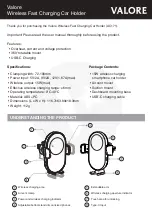
118
The highest SAR value for this model
phone when tested for use at the ear
is 1.26 W/kg and when worn on the
body, as described in this user’s
manual, is 0.70 W/kg. While there
may be differences between SAR
levels of various phones and at
various positions, they all meet the
government requirement for safe
exposure.
SAR information on this model phone
is on file with the FCC and can be
found under the Display Grant section
of http://www.fcc.gov/oet/ea/fccid/
after searching on FCC ID.
To find information that pertains to a
particular model phone, this site uses
the phone FCC ID number which is
usually printed somewhere on the
case of the phone. Sometimes it may
be necessary to remove the battery
pack to find the number. Once you
have the FCC ID number for a
particular phone, follow the
instructions on the website and it
should provide values for typical or
maximum SAR for a particular phone.
Additional information on Specific
Absorption Rates (SAR) can be found
on the Cellular Telecommunications
Industry Association (CTIA) website
at http://www.ctia.org/
*In the United States and Canada,
the SAR limit for mobile phones used
by the public is 1.6 watts/kg (W/kg)
averaged over one gram of tissue.
The standard incorporates a
substantial margin of safety to give
additional protection for the public
and to account for any variations in
measurements.
FCC Hearing-Aid
Compatibility (HAC)
Regulations for Wireless
Devices
On July 10, 2003, the U.S. Federal
Communications Commission (FCC)
Report and Order in WT Docket 01-
309 modified the exception of
wireless phones under the Hearing
Aid Compatibility Act of 1988 (HAC
Act) to require digital wireless phones
be compatible with hearing-aids. The
intent of the HAC Act is to ensure
reasonable access to
telecommunications services for
persons with hearing disabilities.
While some wireless phones are
used near some hearing devices
(hearing aids and cochlear implants),
users may detect a buzzing,
humming, or whining noise. Some
hearing devices are more immune
than others to this interference noise,
and phones also vary in the amount
of interference they generate.
The wireless telephone industry has
developed a rating system for
wireless phones, to assist hearing
device users to find phones that may
be compatible with their hearing
devices. Not all phones have been
rated. Phones that are rated have the
rating on their box or a label located
on the box.
The ratings are not guarantees.
Results will vary depending on the
user's hearing device and hearing
loss. If your hearing device happens
to be vulnerable to interference, you
may not be able to use a rated phone
Safety
US670_Eng_Ver1.1_110527.qxd 2011.5.27 2:7 PM Page 118
Содержание Optimus U US670
Страница 149: ...147 MEMO US670_Eng_Ver1 1_110527 qxd 2011 5 27 2 7 PM Page 147 ...
Страница 150: ...148 MEMO US670_Eng_Ver1 1_110527 qxd 2011 5 27 2 7 PM Page 148 ...
Страница 308: ...MEMO US670_Spa_Ver1 1_110527 qxd 2011 5 27 2 22 PM Page 158 ...
Страница 309: ...MEMO US670_Spa_Ver1 1_110527 qxd 2011 5 27 2 22 PM Page 159 ...
















































